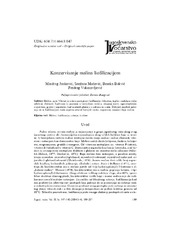Prikaz osnovnih podataka o dokumentu
Preservation of raspberry via liophilization
Konzervisanje malina liofilizacijom
| dc.creator | Janković, Miodrag | |
| dc.creator | Mašović, Snežana | |
| dc.creator | Bukvić, Branka | |
| dc.creator | Vukosavljević, Predrag | |
| dc.date.accessioned | 2020-12-17T18:19:22Z | |
| dc.date.available | 2020-12-17T18:19:22Z | |
| dc.date.issued | 2004 | |
| dc.identifier.issn | 0350-2155 | |
| dc.identifier.uri | http://aspace.agrif.bg.ac.rs/handle/123456789/801 | |
| dc.description.abstract | Due to high water content (about 90%), specific total fruit texture characteristic light color and aroma, up to now raspberry has not been preserved via classical drying. The paper aimed to study the change in quality induced by liophilization as compared to convectively dried and fresh fruit. Cv Willamette was used for the trial. The chemical analyses involved the assessment of the following: the content of soluble solids total acids, total sugar, pH value, L-ascorbic acid, total anthocyanins total aroma, porosity of dried fruits, and organoleptic value. Liophilization was done in Edwards device at fruit temperature of -30°C. The pressure in the chamber accounted for 13 Pa, desorption temperature being 40°C. Convective drying was done in laboratory apparatus, entry air temperature being 65°C and relative humidity 6%. Dried fruits were rehydrated with water at room temperature. In compliance to the results obtained, it may be inferred that the stated method is highly suitable for sensitive fruit drying, such as raspberry. The analyses proved that the quality of convectively dried fruits as compared to liophilizated, is significantly poorer. Preservation of l-ascorbic acid (for about 54%) better maintenance of anthocyanins (for about 51%), reduced loss of total aroma (for about 66%) and reduction volume (for about 92%), higher porosity (for about 49%) and finally better organoleptic value (for about 51%) are the advantages of the method in question. | en |
| dc.description.abstract | Malina, sorta Vilamet je sušena postupkom liofilizacije i klasično, toplim vazduhom niske relativne vlažnosti. Ispitivane su promene u hemijskom sastavu, ukupnoj aromi, organoleptičnim svojstvima, gustini i zapremini, kod osušenih plodova u odnosu na sveže. Dobijeni rezultati pokazuju da se liofilizacijom može uspešno očuvati hemijski sastav, zapremina, aroma i boja maline. | sr |
| dc.publisher | Naučno voćarsko društvo Srbije, Čačak | |
| dc.rights | openAccess | |
| dc.source | Jugoslovensko voćarstvo | |
| dc.subject | malina | sr |
| dc.subject | liofilizacija | sr |
| dc.subject | sušenje | sr |
| dc.subject | kvalitet | sr |
| dc.title | Preservation of raspberry via liophilization | en |
| dc.title | Konzervisanje malina liofilizacijom | sr |
| dc.type | article | |
| dc.rights.license | ARR | |
| dc.citation.epage | 207 | |
| dc.citation.issue | 147-148 | |
| dc.citation.other | 38(147-148): 199-207 | |
| dc.citation.spage | 199 | |
| dc.citation.volume | 38 | |
| dc.identifier.fulltext | http://aspace.agrif.bg.ac.rs/bitstream/id/4311/798.pdf | |
| dc.identifier.rcub | https://hdl.handle.net/21.15107/rcub_agrospace_801 | |
| dc.type.version | publishedVersion |


